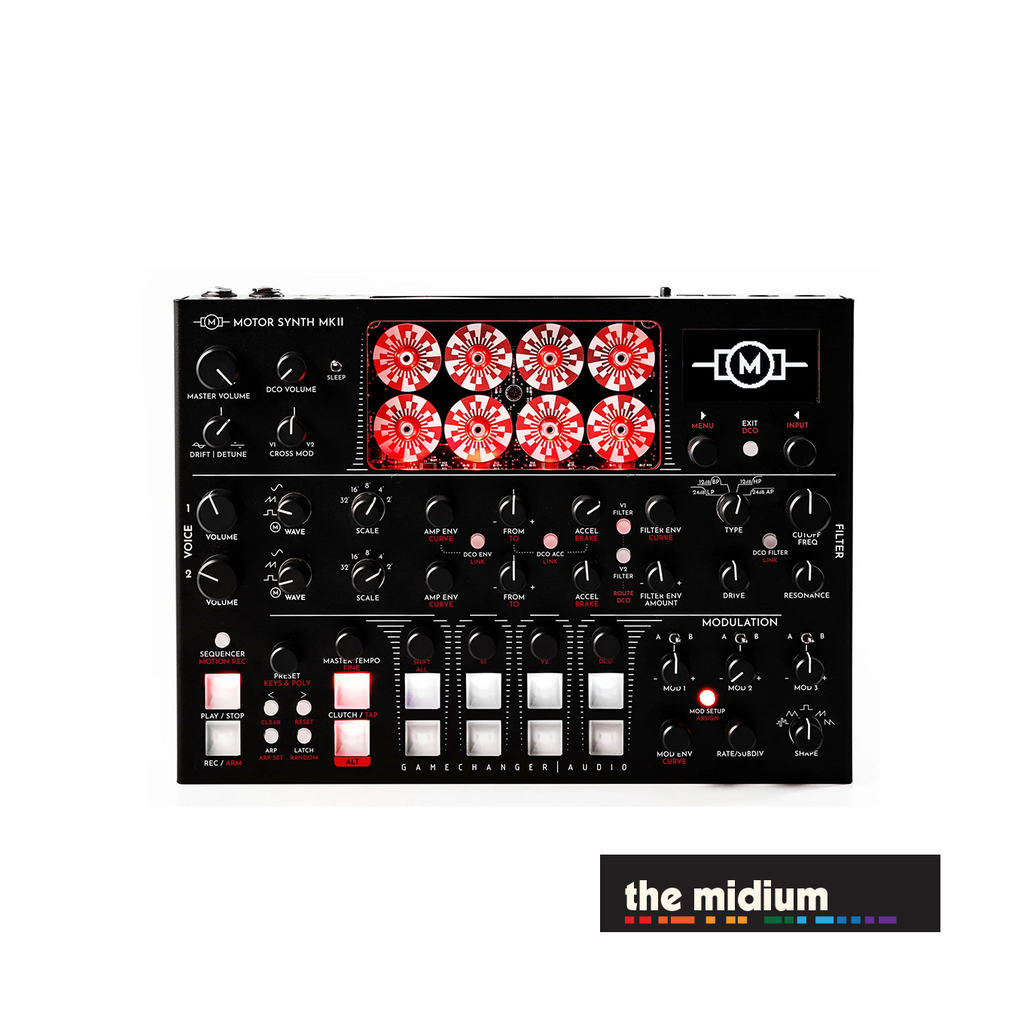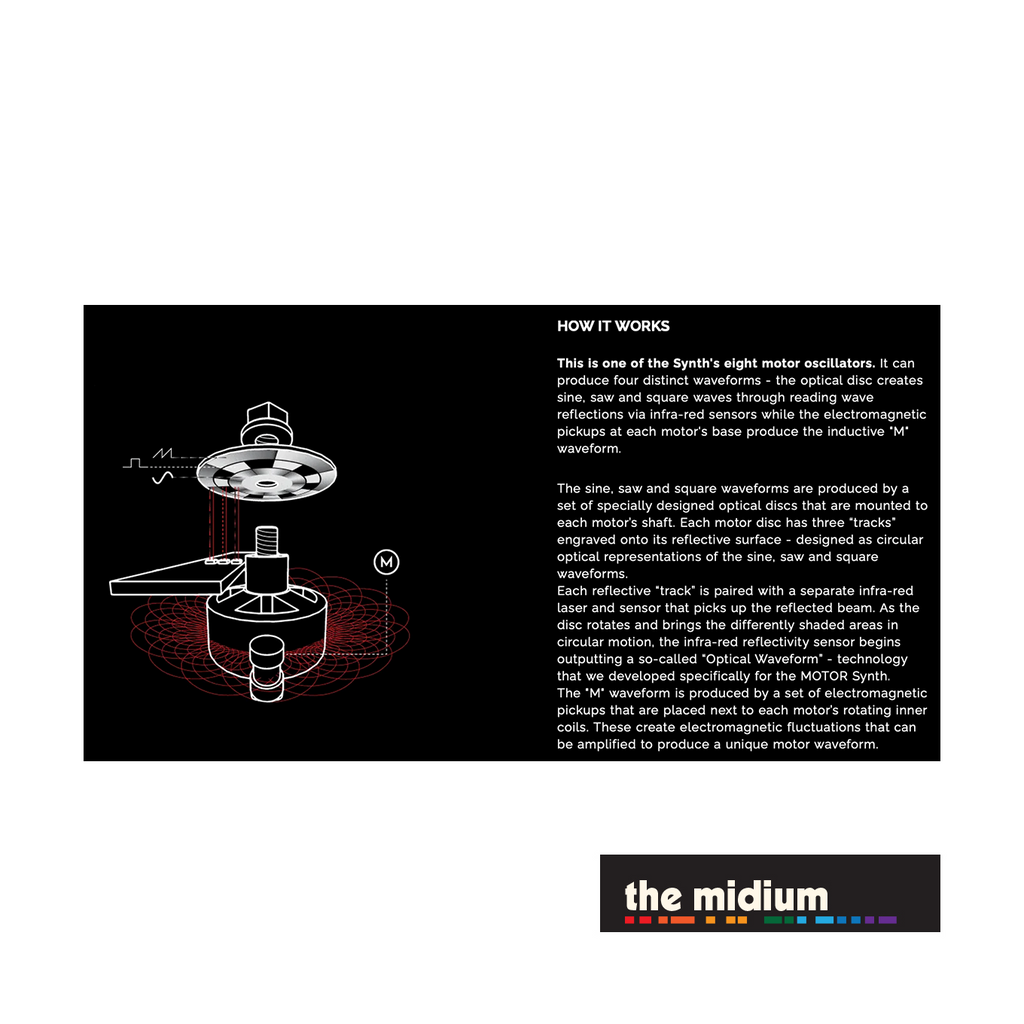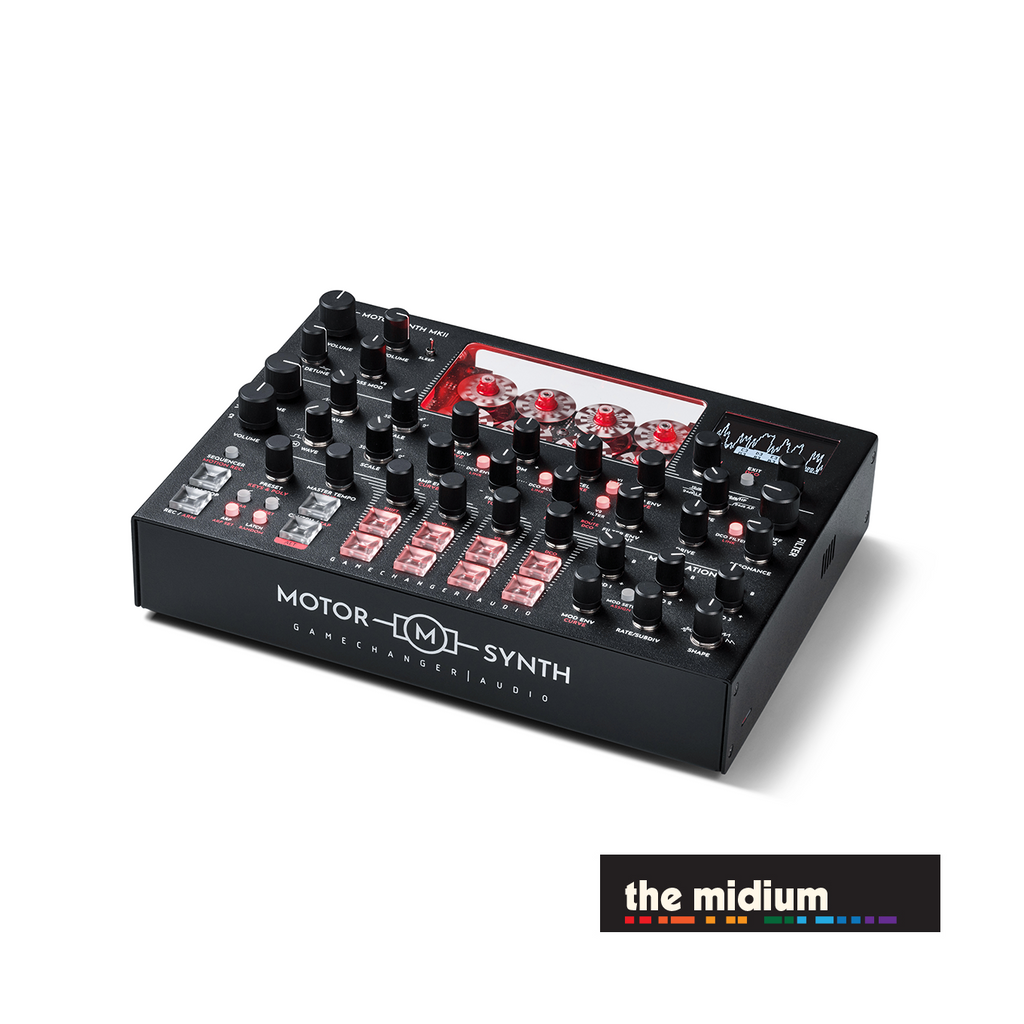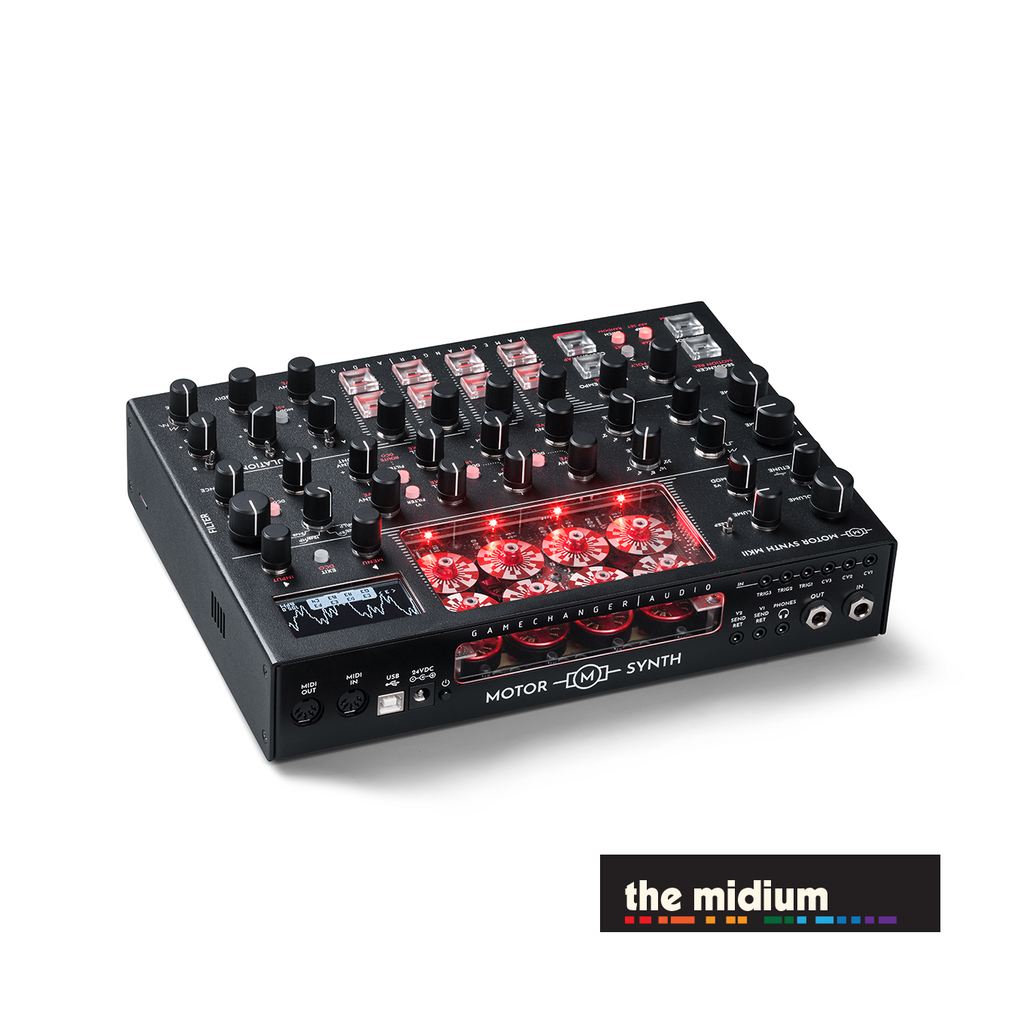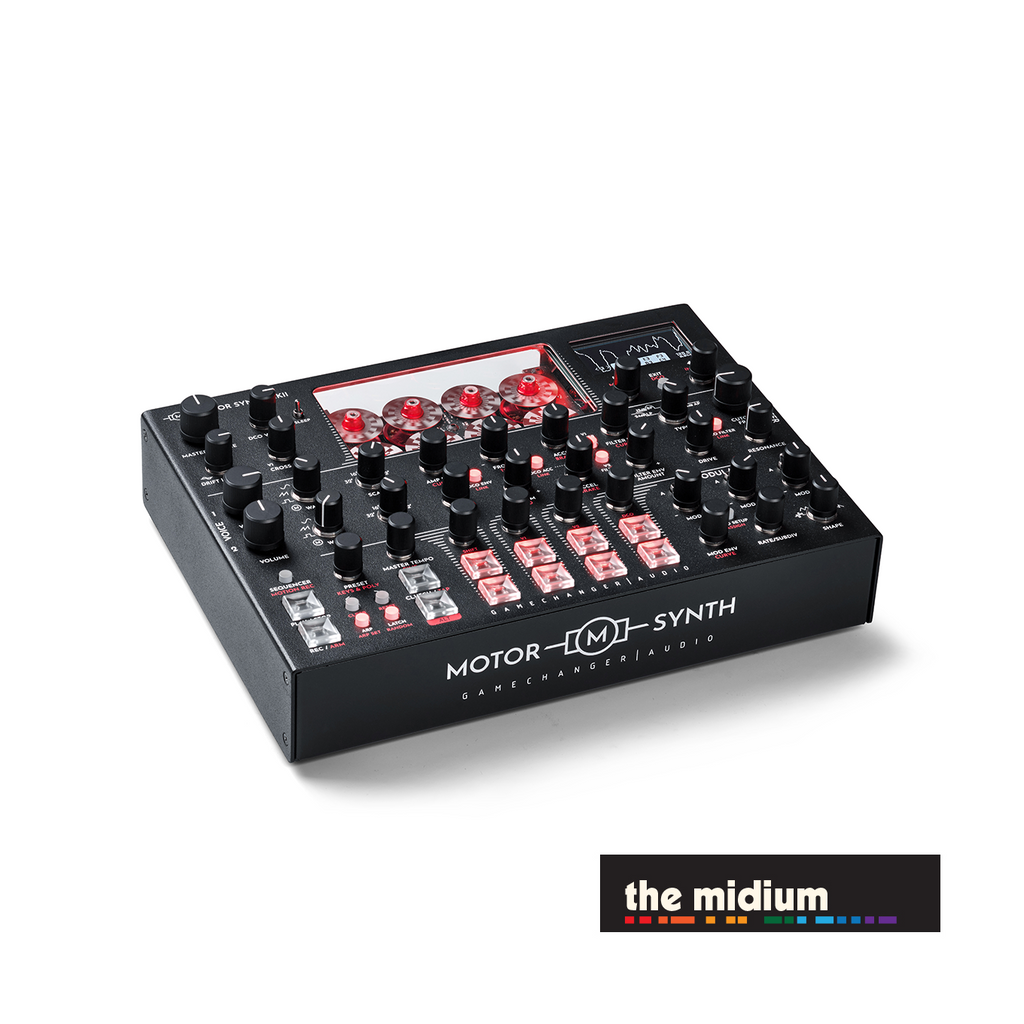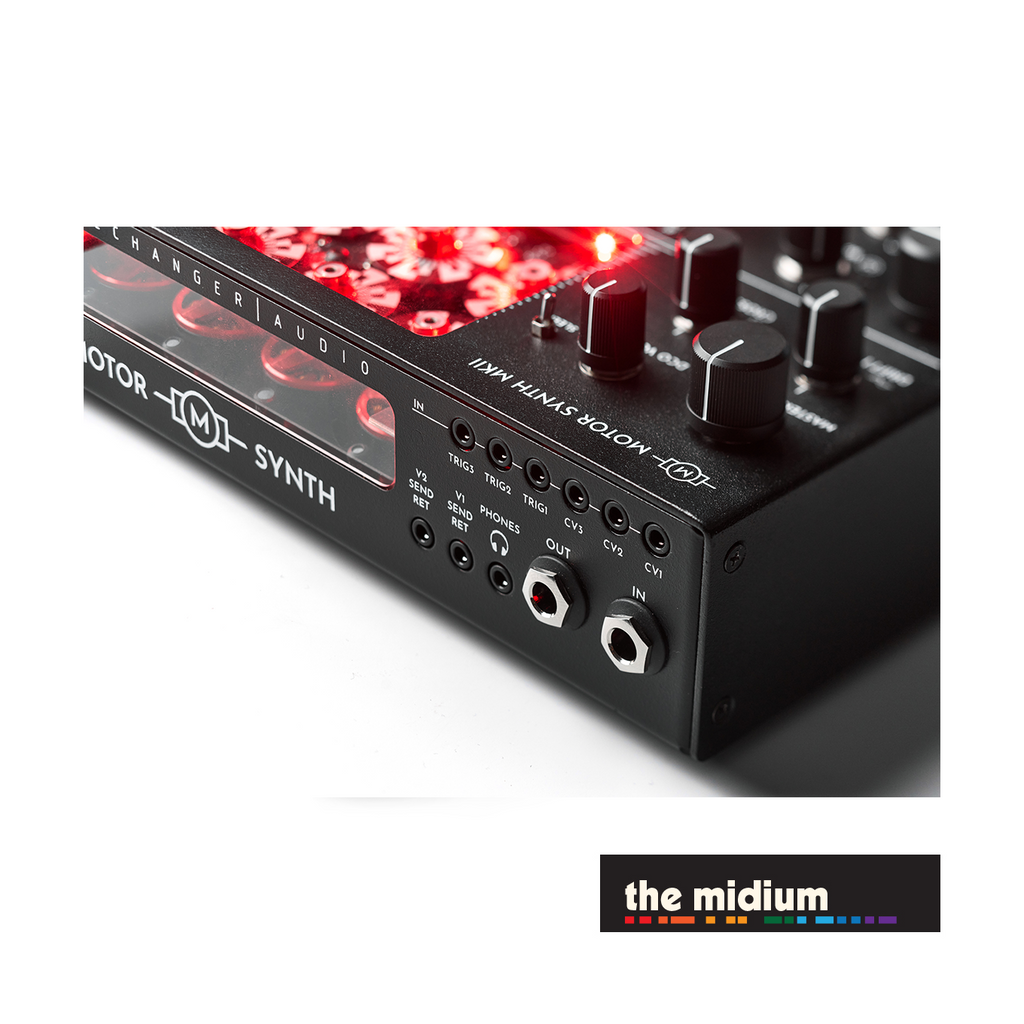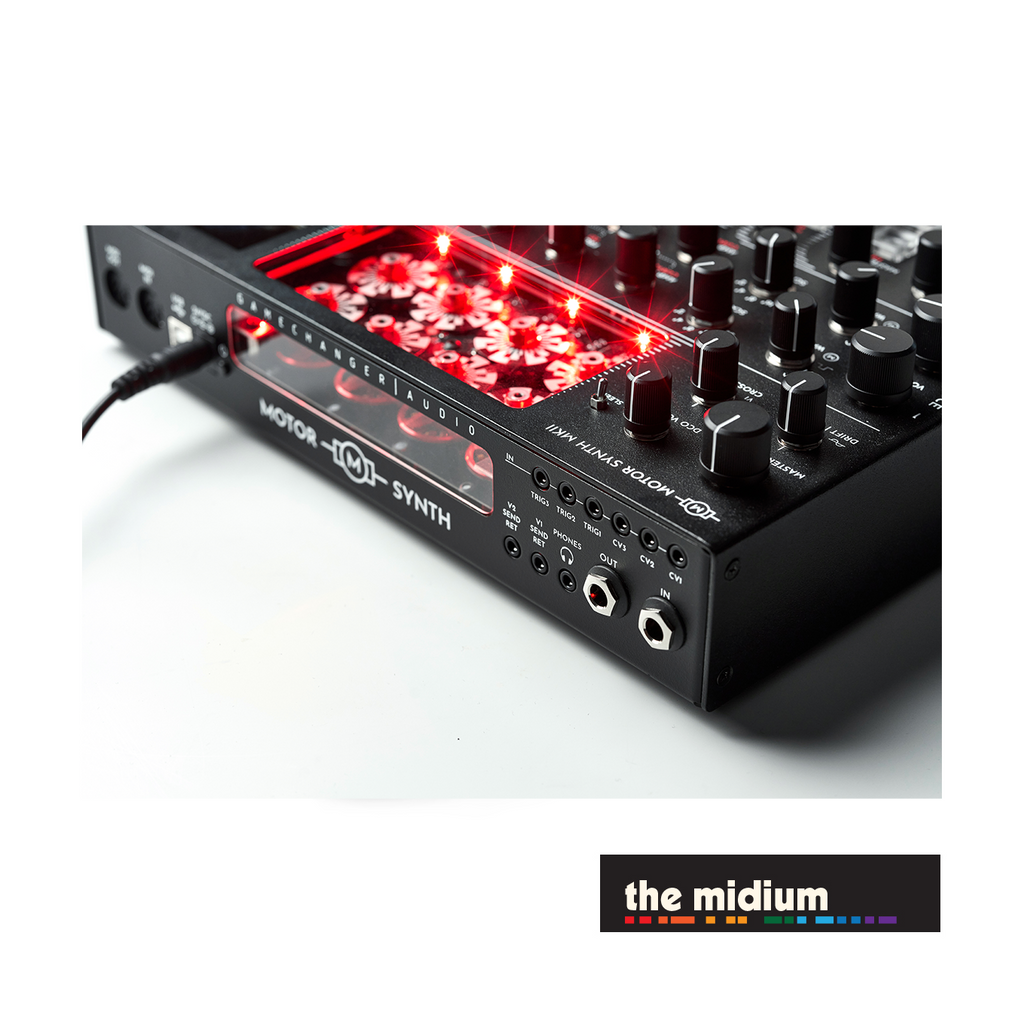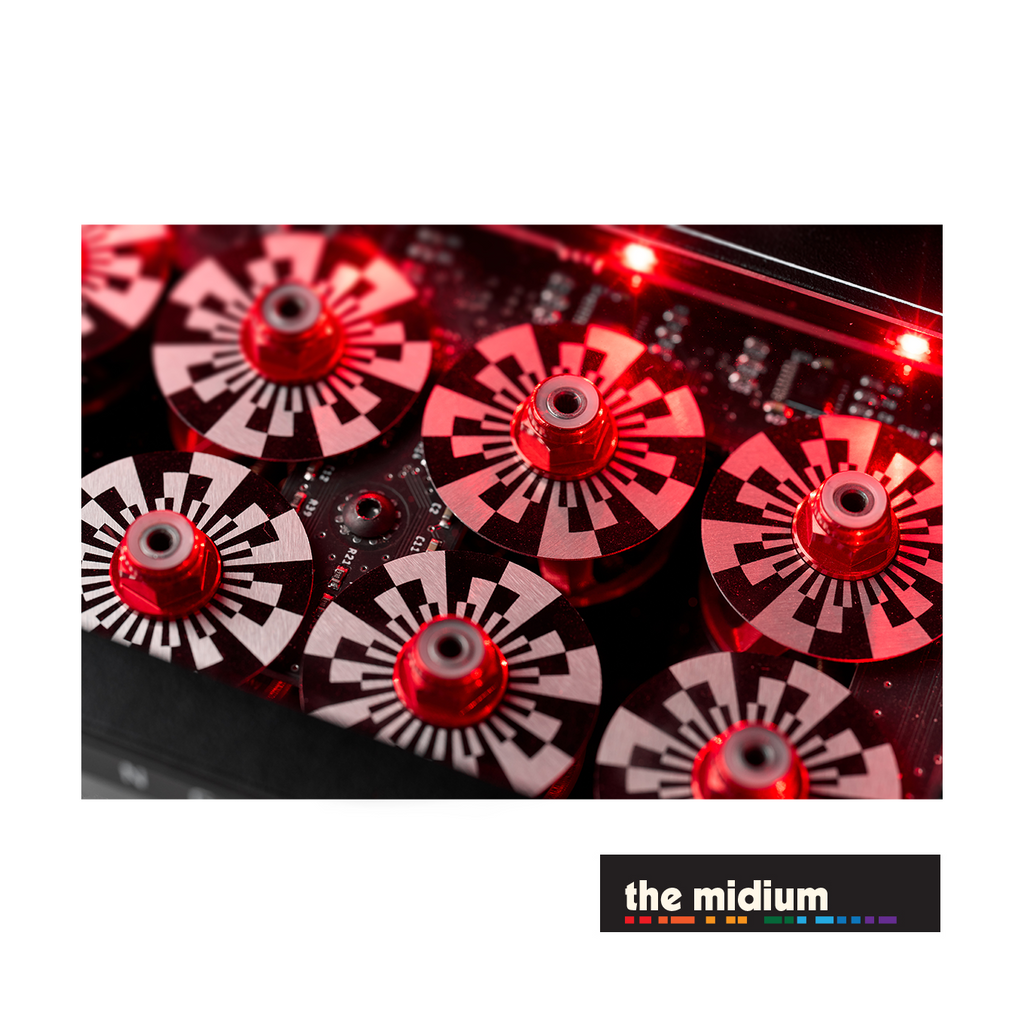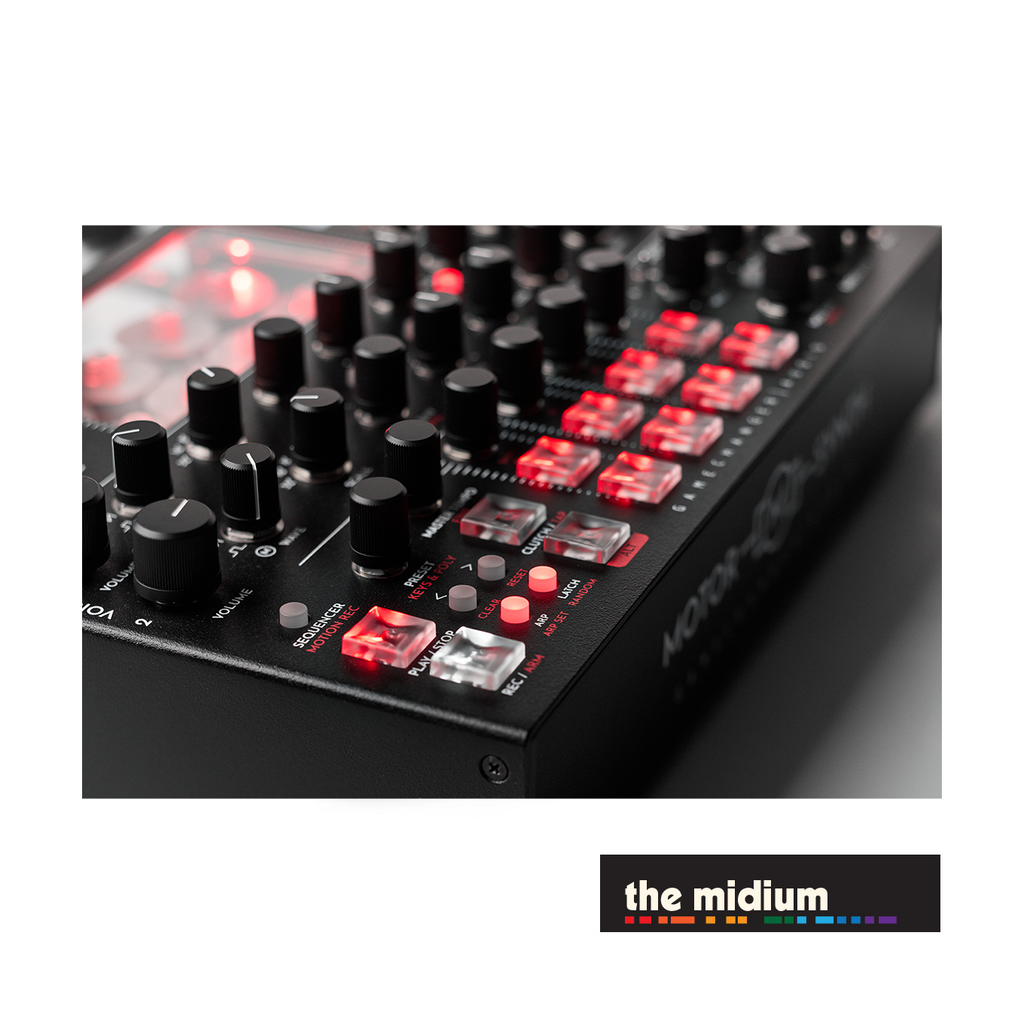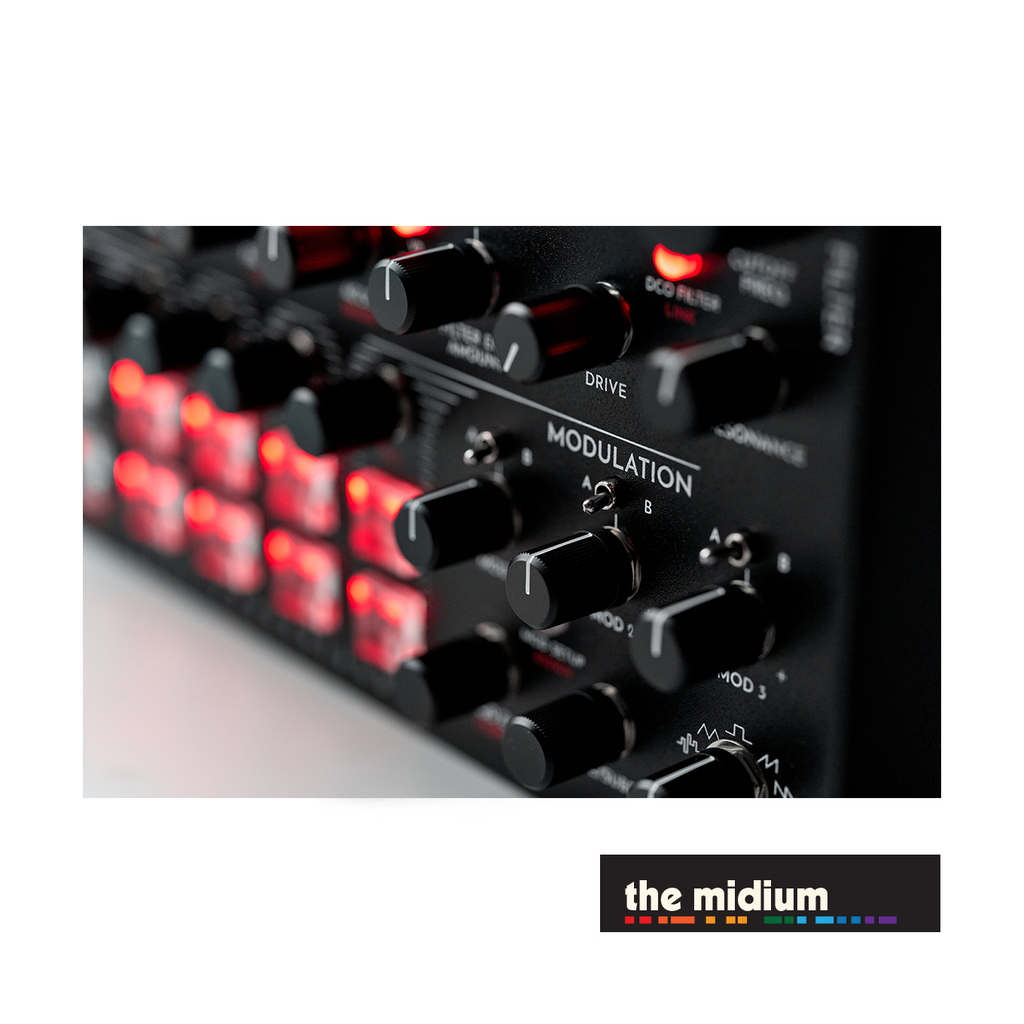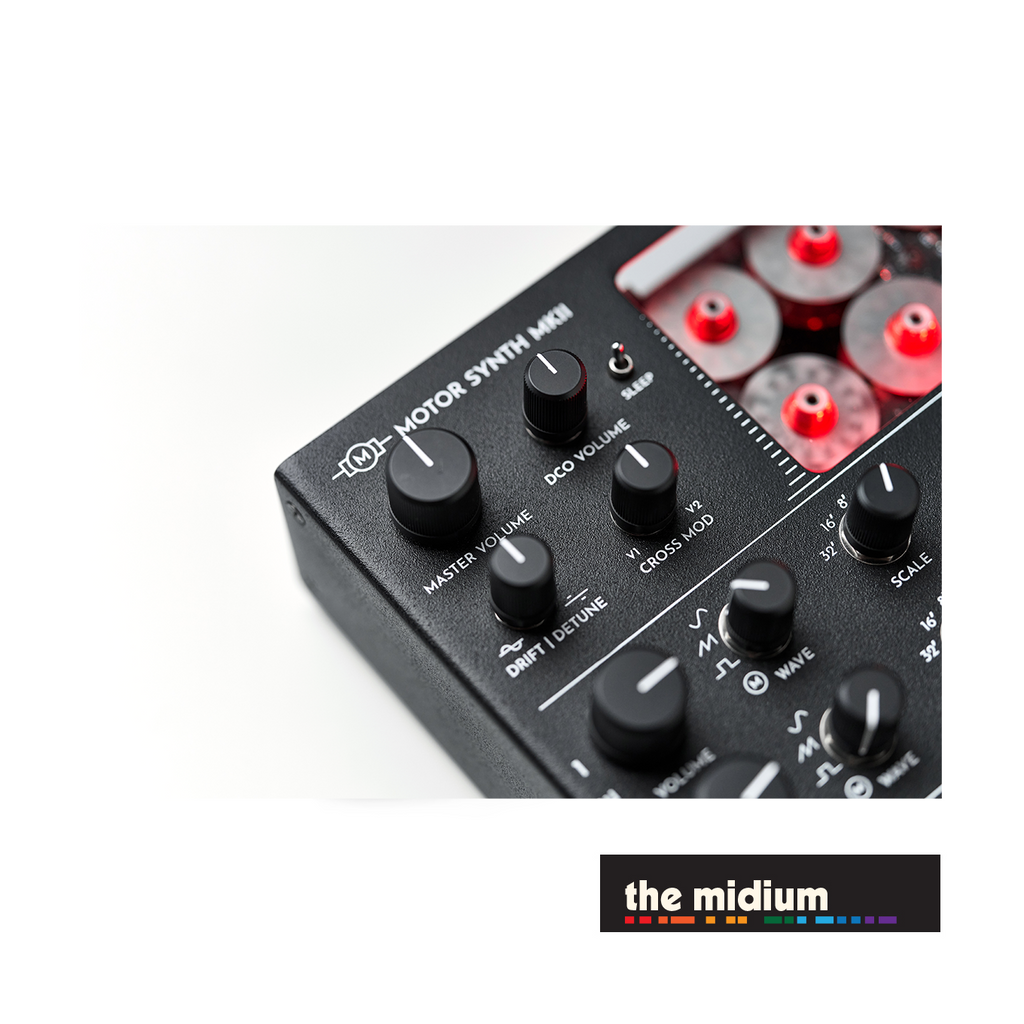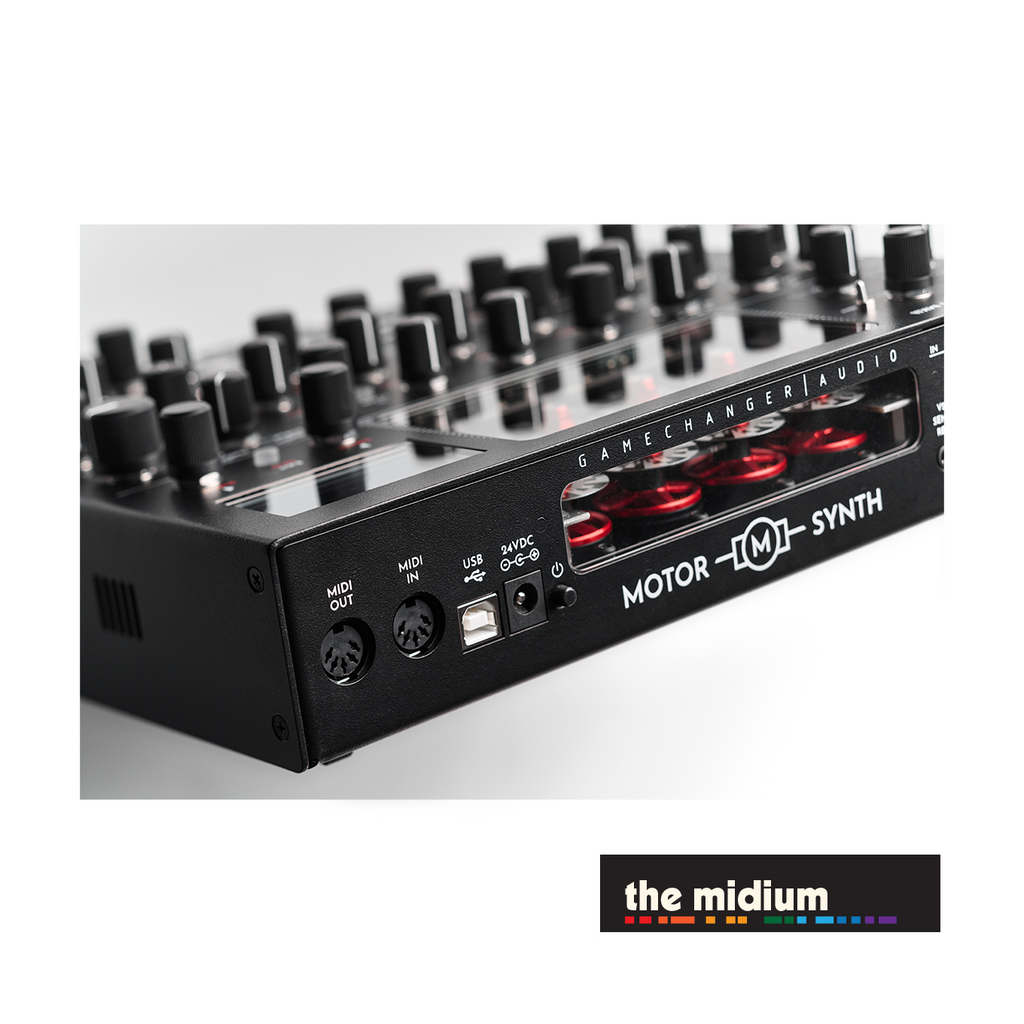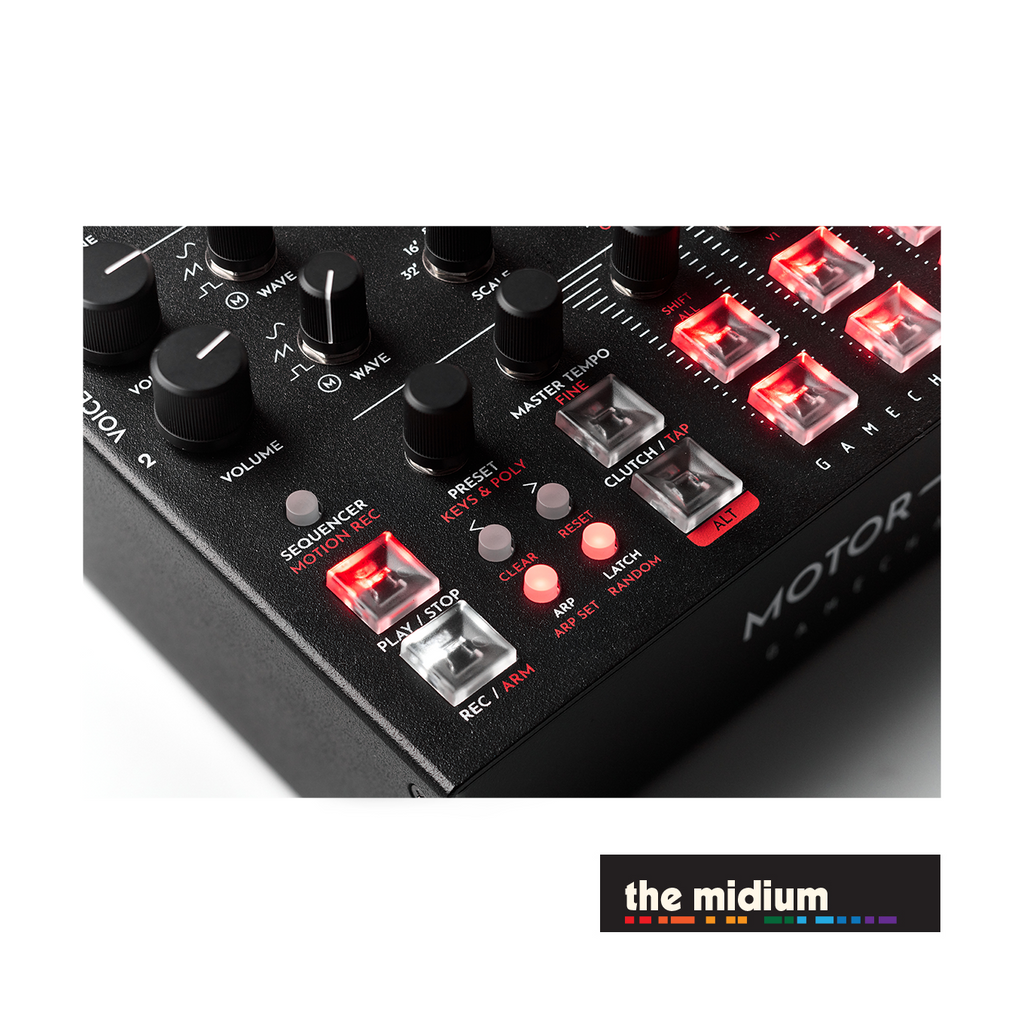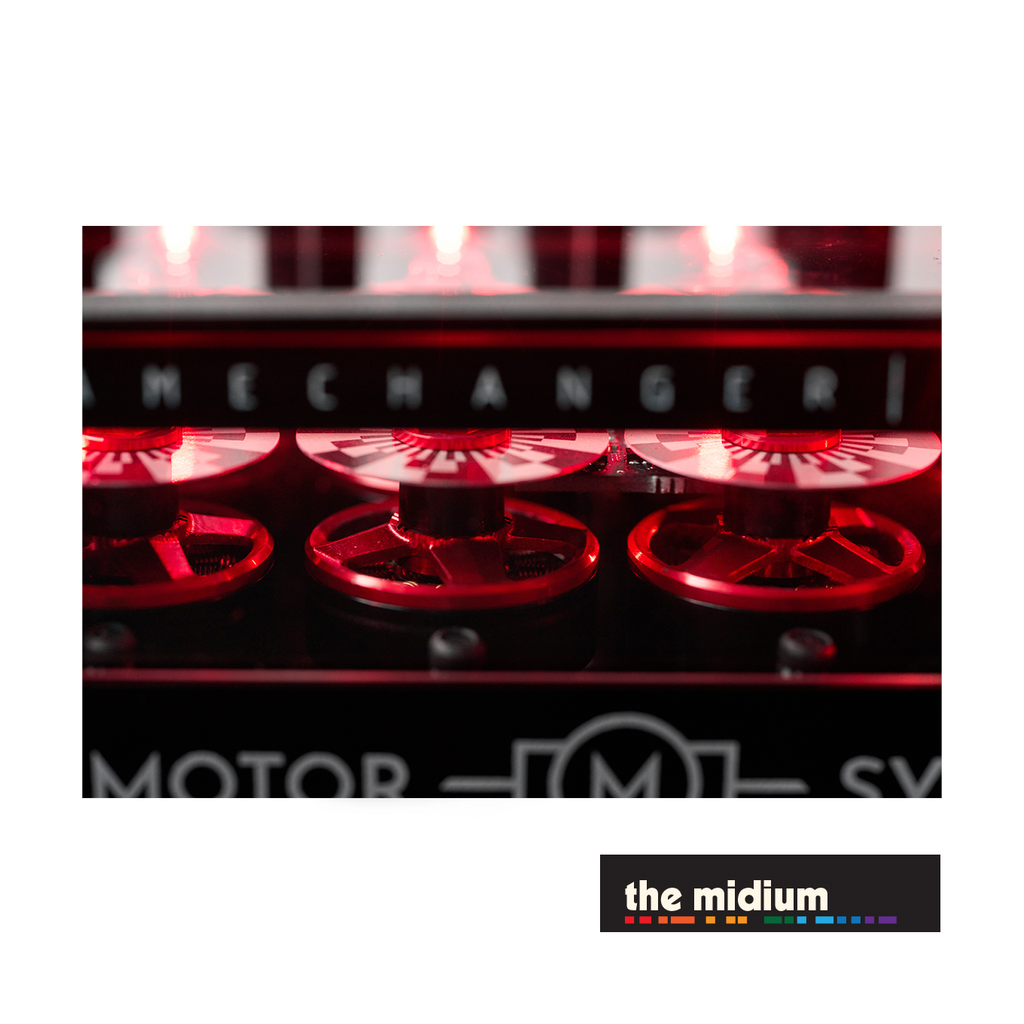Gamechanger Audio's description of the Gamechanger Audio MOTOR Synth MKII electro-mechanical desktop synthesizer
THE MIDIUM® CURATOR'S NOTE: Mechanical noise from a mechanical instrument.
Erin: According to Gamechanger Audio, among its other sound-generating components, the Gamechanger Audio MOTOR SYNTH MKII utilizes "electromotors" to generate the audio signal produced by a system of spinning discs, lasers, sensors, and other circuits. The rate at which the electromotors spin affects the frequencies produced by this non-traditional oscillator system, and considering how these are mechanical parts that spin at relatively high rates, they will generate mechanical noise. The character of the mechanical noise may or may not suit your needs, so we encourage you to start researching these characteristics and to contact us directly with any questions, should you have any. As with other works of art, the Gamechanger Audio MOTOR SYNTH MKII can be appreciated for its own merits and unique qualities, and there are many characteristics to observe, right down to its exceptionally high build quality, non-traditional sound-generating method, and its somewhat overdriven tonal character.
In our tests, The Midium® has found that the faster the motors spin, the more present the mechanical noise becomes, akin to other electromechanical musical instruments and components found throughout the history of music and music production. To allow the artist and producer to control the presence of the motor noise, Gamechanger Audio has introduced a function called "Sleep," which stops the motors from spinning, thereby silencing mechanical noise emanating from the MOTOR SYNTH MKII, save for any noise coming from an internal fan that may be running at the time. The motors go to sleep and "awaken" at the flip of the switch, and go back in tune nearly as quickly, so that the MOTOR SYNTH MKII is ready for you to continue working.
Lastly, since the motors generate noise levels and frequencies relative to the octave to which they are set, the mechanical noise itself can be used for any number of musical experiments, too, including sampling (just bring your own sampler!). Gamechanger Audio mentioned that artists have already experimented with these sounds, including popular and independent artists alike. We have a Gamechanger Audio MOTOR SYNTH MKII in our studio, and we would gladly walk you through any of its functions. My husband and fellow owner of The Midium®, Cam, plays it often and they have enjoyed playing this avant-garde synthesizer. It has quickly become one of their most-played synths. We can also help connect you with the folks at Gamechanger Audio so that they can answer any of your questions, directly.
As mentioned in the beginning, the Gamechanger Audio MOTOR SYNTH MKII has a unique character found in no other electronic musical instrument or synth, so we encourage you to ask us any questions you might have prior to placing an order. We can plan demos, call times, or video calls to suit any schedule, so please get in touch with us! We would love to hear from you!
IT'S ALL ABOUT THE GAME, AND HOW YOU PLAY IT.
The MOTOR Synth is an analog, electro-mechanical synthesizer. It uses electromotors as its main sound source instead of conventional oscillators.
The MOTOR Synth has two ways of producing its core sound. It accelerates eight electromotors to precise rpm’s that correspond with specific musical notes. Each motor has a magnetic pickup placed next to it. The spinning coils result in a very industrial-sounding, exciting and raw analog tone. Think eight harmonious revving engines pumping out an intimidating noise! Special reflective disks are attached to the shafts of each motor.

Each disk contains a graphical representation of three standard audio wave-shapes. As the motors spin, the disks are set into circular motion. Each wave-shape is read by an infrared sensor, then converted into an audio signal
FEATURES.
UNIQUE MOTOR OSCILLATOR ENGINE.
The MOTOR Synth is based on a unique Motor oscillator engine - it is a system of electro-motors that are able to instantly and precisely change their rotation speed in order to produce musical notes. These Motor Oscillators can produce four distinct waveforms - Sine, Saw, Square and the so-called M waveform.
The M waveform is produced by a set of electromagnetic pickups that are placed next to each Motor’s rotating inner coils. As the coils rotate the Motor’s coils create electromagnetic fluctuations that can be amplified to produce a unique Motor waveform.
The Sine, Saw and Square waveforms are produced by a set of specially designed Optical discs that are mounted to each Motor’s shaft. Each Motor Disc has three “tracks” engraved onto its reflective surface. These “tracks” are designed as circular optical representation of the Sine Saw and Square waveforms.
Each reflective “track” is paired with a separate infra-red laser and sensor that picks up the reflected beam. As the disc rotates and brings the differently shaded areas in circular motion, the infra-red reflectivity sensor begins outputting a so-called “Optical Waveform” - a proprietary technology that we developed specifically for the MOTOR Synth.
TWO INDEPENDENT MOTOR VOICES.
The MOTOR Synth offers two separate MOTOR Voices with 4 Electromotor oscillators each - both voices can operate in mono, unison or in four-note polyphonic mode.
Both MOTOR Voices are equipped with a separate set of controls for adjusting VOLUME, SCALE, WAVESHAPE, individual AMP ENVELOPE engines for each musical note, as well as very detailed control over a deep and versatile PORTAMENTO / PITCH MOD section (called “Acceleration / Brake”).
INDEPENDENT MULTI-MODE ANALOG FILTERS.
Both Motor voices are equipped with a separate analog multimode filter section with adjustable DRIVE, CUTOFF, RESONANCE, ENVELOPE SHAPE & AMOUNT and FILTER TYPE.
There are four analog filter types - 24 dB LP, 12 dB BP, 12 dB HP, 12 dB AP (All-Pass). The new analog filter circuits have increased headroom, improved envelope response speed and a very precise analog Keytrack mode with adjustable depth, direction and filter “glide”.
DIGITAL VOICE (DCO).
The MOTOR Synth MK II features an additional third voice - a high quality digital engine that can be used either independently, or to augment the raw sound of the MOTOR Voices. The Digital engine (DCO) can be used to produce various classic waveforms (with waveshaping), or as a noise generator.
The DCO is also equipped with a separate, fully controllable AMP ENVELOPE, PORTAMENTO section, and its own Digital multimode Filter designed to reproduce the 4 analog filter modes.
CONFIGURABLE STEREO OUTPUT.
The MOTOR Synth has a single output jack that can be configured either as mono, or as a stereo output - thus routing the synth's two motor voices into separate channels.
The Digital voice can also be routed to the V1 or V2 outputs, or to both.
MODULATION SECTION WITH THREE ASSIGNABLE LFOS.
The MOTOR Synth MKII also features an extremely powerful modulation section that includes 3 individual LFOs with adjustable positive and negative depth controls. Each LFO can be easily assigned to almost any knob or encoder value on two independent modulation slots A and B.
There are five independent modulation waveforms available for each LFO - each with a detailed waveshaping engine.
CROSS-MODULATION AND DETUNE OPTIONS.
The MOTOR Synth features a dedicated center indent potentiometer for creating amplitude cross-modulation with either Voice 1 or Voice 2.
The Detune / Drift knob gives you two kinds of oscillator detune effects.
ARP, MOTION RECORD, SEQUENCER.
Powerful arpeggiator engine offers detailed control over a large variety of parameters, including note accent, pattern shift, note repeat and more.
Multiple independent motion Record lanes assignable to all sound parameters.
A built-in monophonic sequencer engine with controls for micro-timing, probability, ratchets, pattern length, pattern saving and chaining and much more.
PERFORMANCE KEYBOARD.
Non-velocity sensitive 8 key keyboard with 4 pitch shift encoders - this is a small but powerful note input system with a lot of performance tricks up its sleeve.
Alternatively, the MOTOR Synth is fully MIDI and CV compatible and can be used with all of your favorite keyboards, controllers and sequencers.
SPECS.
|
Sound Engine |
Electro-Mechanical with additional Digital Voice |
|
Signal Path |
All Analog |
|
Polyphony |
4 notes, 3 voices per note |
|
Filters |
Analog multimode VCF 24 dB LP, 12 dB BP, 12 dB HP, 12 dB AP |
|
MIDI support |
Notes, CC, PC, Transport, Ch pressure, NRPN, |
|
Presets & Sequences |
128 Preset banks with 128 Patches each, 64 projects/sequences |
|
Input Type |
1/4” Unbalanced TS |
|
Input Impedance |
500kΩ |
|
Max Input Level |
6Vpp (+9dBu) |
|
Output Type |
1/4” Unbalanced TRS (Stereo) |
|
Output Impedance |
220Ω |
|
Max Output Level |
10Vpp (+13dBu) |
|
Frequency Response |
5Hz to 22kHz |
|
Controls |
See picture |
|
Display |
OLED 128x64 |
|
Connectors |
IN, OUT, Headphone Out, V1 send/ret, V2 send/ret, |
|
Power Supply |
IS INCLUDED, Center positive 3.0 x 6.5 mm barrel plug |
|
Power Requirements |
5A, 24VDC |
|
Mean Power Consumption |
20W |
|
Product Dimensions |
8.3 IN / 21 CM (L) x 11.4 IN / 29 CM (W) x 2.17 IN / 5.5 CM (H) |
|
Product Height with knobs |
2.96 IN / 7.5 CM |
|
Product Weight |
7.17 LBS / 3.25 KG |
|
Shipping Dimensions |
11 IN / 28 CM (L) x 19 IN / 48 CM (W) 4 IN / 10 CM (H) |
|
Shipping Weight |
10.8 LBS / 4.9 KG |

